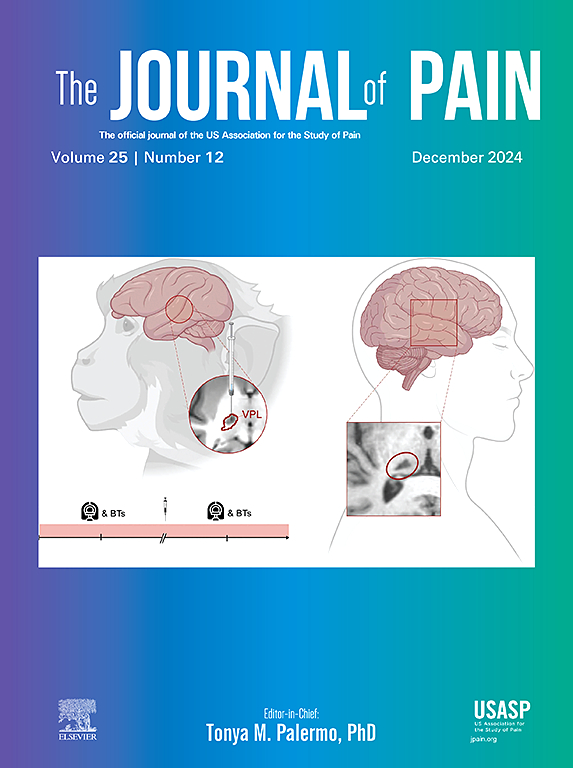Treatment expectations and pain-related outcomes in clinical trials of digital cognitive-behavioral therapy for youth with chronic pain
IF 4
2区 医学
Q1 CLINICAL NEUROLOGY
引用次数: 0
Abstract
Treatment expectations (TE) are predictive of patient outcomes in clinical practice and suggested to moderate treatment responses in chronic pain clinical trials. However, evidence is mainly derived from studies conducted with adult populations with musculoskeletal pain, primarily focused on pharmacological treatments and a few alternative intervention modalities (e.g., acupuncture). We examined the role of pretreatment TE in youth participating in two randomized controlled trials of digital cognitive-behavioral therapy (CBT) for chronic pain—the WebMAP2 Trial of youth with chronic primary pain (n = 273) and the iCC-SCD Trial of youth with sickle cell pain (n = 111). Specifically, we tested: 1) whether controlling for TE enhanced the detection of treatment efficacy, 2) the main effect of TE in predicting pain-related outcomes over time (regardless of treatment assignment), and 3) the effect of TE in moderating treatment efficacy (digital CBT vs education control). Findings indicated that adjusting for pretreatment TE did not enhance the ability to detect treatment efficacy. In the WebMAP2 Trial, higher pretreatment TE were associated with greater reductions in anxiety and lower CBT efficacy (relative to education control) in improving depressive and anxiety symptoms. In the iCC-SCD Trial, higher pretreatment TE were associated with greater improvement in mobility and enhanced CBT efficacy (relative to education control) for improving mobility. Overall, higher pretreatment TE were associated with better functioning over time, though the specific domains of improvement and the moderating effects on treatment efficacy somewhat differed between youth with primary and sickle cell-related chronic pain.
Perspective
Incorporating TE into clinical assessments and ensuring consistent collection, reporting, and analysis in clinical trials are crucial for identifying potential heterogeneous treatment responses. Standardizing TE measures for youth with chronic pain and considering population characteristics are important for understanding TE's role in treatment responses.
数字认知行为治疗青少年慢性疼痛临床试验的治疗预期和疼痛相关结果。
治疗预期(TE)在临床实践中可预测患者预后,并建议在慢性疼痛临床试验中调节治疗反应。然而,证据主要来自对患有肌肉骨骼疼痛的成年人群进行的研究,主要集中在药物治疗和一些替代干预方式(如针灸)。我们通过两项针对慢性疼痛的数字认知行为疗法(CBT)的随机对照试验——针对慢性原发性疼痛青年的WebMAP2试验(n = 273)和针对镰状细胞性疼痛青年的iCC-SCD试验(n = 111),研究了预处理TE在青少年中的作用。具体来说,我们测试了:1)控制TE是否增强了对治疗效果的检测,2)TE在预测疼痛相关结果方面的主要作用(无论治疗分配如何),以及3)TE在调节治疗效果方面的作用(数字CBT与教育控制)。结果表明,调整预处理TE并不能提高检测治疗效果的能力。在WebMAP2试验中,较高的预处理TE与更大程度的焦虑减少和更低的CBT(相对于教育控制)在改善抑郁和焦虑症状方面的疗效相关。在iCC-SCD试验中,较高的预处理TE与更大的活动能力改善和CBT改善活动能力的效果(相对于教育控制)相关。总体而言,随着时间的推移,较高的预处理TE与更好的功能相关,尽管在原发性和镰状细胞相关慢性疼痛的青年患者中,具体的改善领域和治疗效果的调节作用有所不同。观点:将TE纳入临床评估并确保临床试验中一致的收集、报告和分析对于识别潜在的异质性治疗反应至关重要。标准化青少年慢性疼痛的TE措施并考虑人群特征对于理解TE在治疗反应中的作用非常重要。
本文章由计算机程序翻译,如有差异,请以英文原文为准。
求助全文
约1分钟内获得全文
求助全文
来源期刊

Journal of Pain
医学-临床神经学
CiteScore
6.30
自引率
7.50%
发文量
441
审稿时长
42 days
期刊介绍:
The Journal of Pain publishes original articles related to all aspects of pain, including clinical and basic research, patient care, education, and health policy. Articles selected for publication in the Journal are most commonly reports of original clinical research or reports of original basic research. In addition, invited critical reviews, including meta analyses of drugs for pain management, invited commentaries on reviews, and exceptional case studies are published in the Journal. The mission of the Journal is to improve the care of patients in pain by providing a forum for clinical researchers, basic scientists, clinicians, and other health professionals to publish original research.
 求助内容:
求助内容: 应助结果提醒方式:
应助结果提醒方式:


